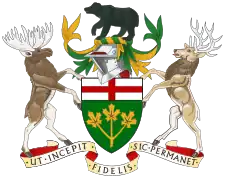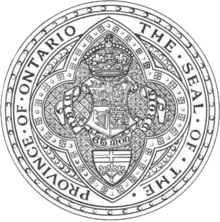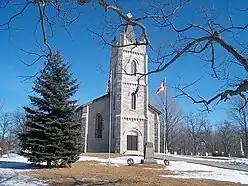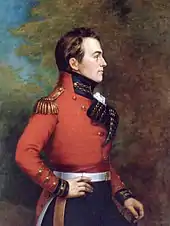| King in Right of Ontario | |
|---|---|
Provincial | |
 | |
| Incumbent | |
.jpg.webp) | |
| Charles III King of Canada since 8 September 2022 | |
| Details | |
| Style | His Majesty |
| First monarch | Victoria |
| Formation | 1 July 1867 |
By the arrangements of the Canadian federation, Canada's monarchy operates in Ontario as the core of the province's Westminster-style parliamentary democracy.[1] As such, the Crown within Ontario's jurisdiction may be referred to as the Crown in Right of Ontario,[2] His Majesty in Right of Ontario,[3] the King in Right of Ontario,[4] or His Majesty the King in Right of Ontario.[5] The Constitution Act, 1867, leaves many functions in Ontario specifically assigned to the sovereign's viceroy, the lieutenant governor of Ontario,[1] whose direct participation in governance is limited by the constitutional conventions of constitutional monarchy.[6]
Constitutional role
The role of the Crown is both legal and practical; it functions in Ontario in the same way it does in all of Canada's other provinces, being the centre of a constitutional construct in which the institutions of government acting under the sovereign's authority share the power of the whole.[7] It is thus the foundation of the executive, legislative, and judicial branches of the province's government.[8] The Canadian monarch—since 8 September 2022, King Charles III—is represented and his duties carried out by the lieutenant governor of Ontario, whose direct participation in governance is limited by the conventional stipulations of constitutional monarchy, with most related powers entrusted for exercise by the elected parliamentarians, the ministers of the Crown generally drawn from among them, and the judges and justices of the peace.[6] The Crown today primarily functions as a guarantor of continuous and stable governance and a nonpartisan safeguard against the abuse of power.[6][9][10]

This arrangement began with the 1867 British North America Act[1] and continued an unbroken line of monarchical government extending back to the early 17th century. Though it has its own government headed by the King, as a province, Ontario is not itself a kingdom.[11]
There is currently no government house in Ontario. A viceregal suite in the Ontario Legislative Building in Toronto is used both as an office and official event location by the lieutenant governor, the sovereign, and other members of the royal family. The lieutenant governor resides in their own private residence, though may be provided accommodations by the provincial government if they are not from Toronto. The King and his relations reside at a hotel, usually the Fairmont Royal York, when in Toronto.[12][13]
Royal associations
Those in the royal family perform ceremonial duties when on a tour of the province; the royal persons do not receive any personal income for their service, only the costs associated with the exercise of these obligations are funded by both the Canadian and Ontario Crowns in their respective councils.[14] Monuments around Ontario mark some of those visits, while others honour a royal personage or event. Further, Ontario's monarchical status is illustrated by royal names applied to regions, communities, schools, and buildings, many of which may also have a specific history with a member or members of the royal family; for example, Ontario has at least 47 distinct features named for Queen Victoria: one county, one township, 14 populated places, and 31 physical features.[15] Associations also exist between the Crown and many private organizations within the province; these may have been founded by a royal charter, received a royal prefix, and/or be honoured with the patronage of a member of the royal family. Examples include the Royal Hamilton Yacht Club, which is under the patronage of Charles III and received its royal designation from Queen Victoria in 1891,[16] and the Royal Conservatory of Music in Toronto, which, though founded in 1886, was constituted through royal charter by King George VI in 1947.
The main symbol of the monarchy is the sovereign himself, his image (in portrait or effigy) thus being used to signify government authority.[17] A royal cypher or crown may also illustrate the monarchy as the locus of authority, without referring to any specific monarch. Further, though the monarch does not form a part of the constitutions of Ontario's honours, they do stem from the Crown as the fount of honour and, so, bear on the insignia symbols of the sovereign.
History
Origins
The modern Crown's place in Ontario results, in part, from the French monarchy's history in New France (mostly in the Pays d'en Haut region; today southern Ontario), from the 16th century to the transfer of the territory to the British Crown in 1763, and, in part, from the establishment of Ruperts Land by royal proclamation of King Charles II of England in 1670, which included what is now northern Ontario.
American refugees and American invaders
During and following the American Revolutionary War, which took place between 1775 and 1783, some 46,000 American settlers loyal to the Crown, known as the United Empire Loyalists, fled north to the Province of Quebec (formerly a part of New France, until the British were given control in 1763) and other colonies in the Canadas. The King-in-Council granted each family 0.81 square kilometres (200 acres) of land. From then, Ontario residents descended from these original refugees may use the post-nominals UE, standing for United Empire,[18] and the Canadian Heraldic Authority can grant them distinctive coronets in their coats of arms.[19]
Additionally, thousands of Iroquois and other Aboriginals were expelled from New York and other states, resettling under the protection of the Crown in what is now Ontario.[20] In particular, Governor of the Province of Quebec Frederick Haldimand issued a royal proclamation (known as the Haldimand Proclamation) granting land to the Mohawk people who had served the British Crown through the revolution. The proclamation stated:
Whereas His Majesty, having been pleased to direct that, in consideration of the early attachment to his cause manifested by the Mohawk Indians, and of the loss of their settlement which they thereby sustained, that a convenient tract of land under his protection should be chosen as a safe and comfortable retreat for them and others of the Five Nations, who have either lost their settlements within the Territory of the American States, or wish to retire from them to the British, I have at the earnest desire of many of these, His Majesty's faithful allies, purchased a tract of land from the Indians situated between the Lakes Ontario, Erie, and Huron, and I do hereby, in His Majesty's name, authorize and permit the said Mohawk Nation and such others of the Five Nation Indians as wish to settle in that quarter to take possession of and settle upon the banks of the river commonly called Ours [Ouse], or Grand River.
On this land, the Crown in 1785 erected the Mohawk Chapel, in Brantford, as a gift to the Mohawk people and their then-leader, Joseph Brant. At the same time, the King provided lands near Belleville to the displaced Tyendinaga Mohawks. There, too, a chapel was built, today known as the Christ Church Royal Chapel. The Mohawks brought there the silver communion set given to them by Queen Anne in 1711, as a symbol of the alliance between the Crown and the Mohawks. Further gifts from monarchs included a triptych in the Mohawk language and a bell from King George III, a royal coat of arms of the United Kingdom from King George V, a bible from Queen Victoria, and a communion chalice from Queen Elizabeth II (given in 1984 to mark the bicentennial of the Mohawks arrival in Ontario), in addition to a set of eight silver handbells. The churches are now two of the three chapels royal in Canada.
A few dozen Black Loyalists also settled in the western region of the Province of Quebec; although, not nearly as many as those who located themselves in Nova Scotia. The majority of black inhabitants of Pays d'en Haut were slaves brought into the colony by the Loyalists,[20][21] including Brant.
It was the attempted forced return to the United States of one of those slaves—Chloe Cooley—in 1793 that prompted the abolitionist John Graves Simcoe, then serving as King George III's representative in Upper Canada (a territory formed out of the western portion of the Province of Quebec in 1791, because of the influx of Loyalists), to push for legislation abolishing slavery in the colony. Though he faced resistance from the Legislative Assembly, Simcoe, later that year, gave royal assent to the Act Against Slavery, making Upper Canada "the first jurisdiction in the British Empire to pass a law freeing slaves."[22][23]
Prince Edward, a son of King George III, visited Upper Canada eight months after its establishment, becoming the first member of the royal family to tour the area, seeing Cornwall, Kingston, Prince Edward County, Niagara-on-the-Lake, going so far as Fort Erie. Along the way, he met with Loyalists and various First Nations delegations, helping to foster a British identity for Upper Canada. Along with Simcoe, the Prince Edward made a point of visiting Forts Niagara and Scholsser, getting himself involved in a boundary dispute with the United States in the process.[24]
The United States endeavoured to conquer the Canadas in the War of 1812;[30] all the American parties involved assumed their troops would be greeted as liberators.[31] When the US Army first invaded, crossing the Detroit River and landing at Sandwich (today Windsor) on 12 July,[32] the commander, William Hull ordered all subjects of the King to surrender, telling them he desired to free them from the "tyranny" of Britain and give them liberty, security, and wealth, unless they preferred "war, slavery, and destruction."[33][34] The loyal among the Upper Canadians chose the King and war to defend him, whereas American immigrants who'd settled in Upper Canada merely for the free land chose neutrality, stating they would neither obey British orders to march against Hull, nor "a man would join Hull to fight against the King."[35] Hull retreated across the river on 7 August,[36] but, the US made repeated incursions into Upper Canada through to 1814 and the British regulars, warriors of the Six Nations and Seven Nations,[37] and free-African-[38] and European-Canadians (the volunteers who were colloquially said to be "taking the King's shilling"[39]) reisited them at every try. By the time the Treaty of Ghent was signed on 24 December 1814, ending the war, the United States made no gains into the Canadas.
Rebellion
The republican agitations of Louis-Joseph Papineau in Lower Canada in the late 1830s spread quickly to Upper Canada. These met with agreeable circumstances in western colony, including a politically active lieutenant governor, Francis Bond Head, who had, since 1834,[40] thwarted the efforts of the Reform party-dominated Legislative Assembly,[41] to the point the Executive Council resigned and Head actively campaigned for the Tories in the subsequent election,[42] equatng voting for that party with showing loyalty to the Crown.[43] The Reformers' leader, William Lyon Mackenzie, attempted to petition the King to have the election declared invalid, but, was dismissed by the Colonial Office in London. Meanwhile, the now Tory majority in the Upper Canada parliament passed laws that were self-serving to Tory parliamentarians and burdensome on farmers, increased the colony's debt,[44] and continued the legislative session even after the death of William IV in 1837.[45]
On 9 October of that year, Mackenzie received a message from Papineau's Patriotes in Lower Canada, informing him that the rebellion there was about to begin.[46] A month later, Mackenzie published a satirical piece in his magazine, the Constitution, that included a draft republican constitution for the "State of Upper Canada"[47] and he printed handbills declaring independence, which were distributed to citizens north of Toronto.[48] Actual armed rebellion broke out in Upper Canada on 5 December.[49] Of it, the new Queen, Victoria, wrote in her diary, "the news are, I grieve to say, very bad from Canada; that is to say, rumours and reports by the papers; though, we have no official reports. But [Prime Minister] Lord Melbourne hopes it may not be so bad as it is rumoured. There certainly is open rebellion."[50]
The Queen need not have worried about Upper Canada, however, as the uprising was put down within a matter of days. Mackenzie and 200 supporters fled to Navy Island in the Niagara River and declared it the Republic of Canada on 13 December. That sustained until 13 January 1838, when, under attack by British armaments, the rebels fled, with Mackenzie running to the United States mainland, where he was arrested for violating the Neutrality Act.[51] In the wake of the disturbances, the Queen called on her people in Upper Canada to eschew vengeance on the perpetrators in favour of justice and,[52] as a mark of goodwill with which to begin her reign and to commemorate her coronation, the Victoria used her royal prerogative to pardon many of the rebels, continuing to do so through the 1840s.[53]
Responsible government
The Queen's representative in British North America, the Earl of Durham, penned a report containing recommendations for change following the Lower and Upper Canada Rebellions. Based on that document, the Act of Union 1840 was passed by the parliament at Westminster and proclaimed in effect by Queen Victoria on 10 February 1841, thus renaming Upper and Lower Canada as Canada West (today Ontario) and Canada East (today Quebec), respectively, and merging them to form the Province of Canada, with a governor general to represent the monarch and housed at Monklands, in Montreal. Five years later, the Legislative Assembly of the Province of Canada made Victoria's birthday, 24 May, a public holiday called Victoria Day.[53]

When, in 1848, Robert Baldwin and Louis-Hippolyte Lafontaine were reappointed as Joint Premiers, responsible government was implemented in the colony, with the backing of Queen Victoria.[54] This meant the governor general was to act on the advice of his co-prime ministers, who were responsible to the elected parliament. The first test of this came in the same year, when the Rebellion Losses Act was put to Governor General the Earl of Elgin for royal assent. Elgin had strong misgivings about the bill, and was pressured by the Tories to refuse assent, but he gave it approval, regardless, on 28 April 1849. As a result, the Anglophone population of Montreal (where the legislature was located) became incensed, the Governor General was assaulted,[55] the parliament building was burned,[56] and the Montreal Annexation Manifesto was issued, calling for the absorbption of the Province of Canada into the United States.[57]
Still, all was not lost: The portrait of Queen Victoria that hung in the parliament, painted by John Partridge,[58] was saved from the fire by Sandford Fleming (and hangs in the federal Parliament of Canada today[58]),[59][60] the colony did not join the US, and responsible government remained a part of the Province of Canada's constitutional order.
The Queen's eldest son and heir, Prince Albert Edward (later King Edward VII) for four months toured the Maritimes and Province of Canada in 1860, setting the cornerstone of the parliament building in Bytown (today Ottawa) and officially opening Queen's Park in Toronto.[61] At Dundurn Castle, in Hamilton, Albert Edward met with Allan MacNab, a former joint premier of the Province of Canada. In a twist of fate, the Prince's great-great-grandson, King Charles III, married Camilla Shand (now Queen Camilla), the great-great-great-granddaughter of MacNab. The Prince also crossed the border to pay a visit to President of the United States James Buchanan at the White House.[61]
Sectarian tensions were high in Canada at the time and Prince Albert Edward was cautioned not to do or say anything that might exacerbate the situation. The Duke of Newcastle, who accompanied the Prince, instructed the Mayor of Toronto to ensure Albert Edward's procession would not pass under any Orange Order arches. At Kingston, the Duke ordered the royal yacht not to dock, as the Orangemen had erected a welcoming arch on the pier, with an image of William of Orange on one side and a depiction of the Albert Edward with the anti-Catholic revolutionary Giuseppe Garibaldi on the other. Orangemen thereafter protested the Prince's steamer along part of its route.[62]
Confederation
The province of Ontario was created from the boundaries of Canada West following Canadian Confederation in 1867. The next year, on 26 May, Queen Victoria issued a royal warrant granting the province its coat of arms.[63] Several areas were incorporated into Ontario in the mid 19th and early 20th century, with Ontario reaching its final size in 1912.
See also
References
- 1 2 3 Victoria (29 March 1867). "Constitution Act, 1867". III.9, V.58. Westminster: Queen's Printer. Retrieved 15 January 2009 – via Solon.org.
- ↑ Elizabeth II (25 July 2007). "Municipal Tax Assistance Act". 1. Toronto: Queen's Printer for Ontario. Retrieved 2 July 2009.
- ↑ Elizabeth II (12 February 2007). "Environmental Protection Act". 2.1.i. Toronto: Queen's Printer for Ontario. Retrieved 2 July 2009.
- ↑ Pinet v. The Queen in right of Ontario, Title (Ontario Court of Appeal 13 April 1995), Text.
- ↑ Her Majesty the Queen in Right of Ontario as Represented by the Minister of Finance (Motor Vehicle Accident Claims Fund) and CGU Group Canada Ltd. (Commercial Union Assurance Company of Canada), Title (Arbitration pursuant to the Arbitration Act, 1991, S.O. 1991, c. 17 3 March 2000), Text. archived on 9 November 2015
- 1 2 3 MacLeod, Kevin S. (2008), A Crown of Maples (PDF) (1 ed.), Ottawa: Queen's Printer for Canada, p. 16, ISBN 978-0-662-46012-1, archived (PDF) from the original on 18 March 2009, retrieved 21 June 2009
- ↑ Cox, Noel (September 2002). "Black v Chrétien: Suing a Minister of the Crown for Abuse of Power, Misfeasance in Public Office and Negligence". Murdoch University Electronic Journal of Law. Perth: Murdoch University. 9 (3): 12. Retrieved 17 May 2009.
- ↑ Privy Council Office (2008), Accountable Government: A Guide for Ministers and Ministers of State – 2008, Ottawa: Queen's Printer for Canada, p. 49, ISBN 978-1-100-11096-7, archived from the original on 24 September 2009, retrieved 17 May 2009
- ↑ Roberts, Edward (2009), "Ensuring Constitutional Wisdom During Unconventional Times" (PDF), Canadian Parliamentary Review, Ottawa: Commonwealth Parliamentary Association, 23 (1): 15, archived from the original (PDF) on 26 April 2012, retrieved 21 May 2009
- ↑ MacLeod 2008, p. 20
- ↑ Forsey, Eugene (1974), "Crown and Cabinet", in Forsey, Eugene (ed.), Freedom and Order: Collected Essays, Toronto: McClelland & Stewart Ltd. (published 31 December 1974), ISBN 978-0-7710-9773-7
- ↑ Connor, Kevin (21 April 2016). "An inside look at the Queen's Royal York suite". The Toronto Sun. Postmedia Network Inc. Retrieved 12 September 2018.
- ↑ Blizzard, Christina (20 April 2016), "See how the Queen lives at the Royal York", The Toronto Sun, Postmedia Network Inc., retrieved 12 September 2018
- ↑ Palmer, Sean; Aimers, John (2002), The Cost of Canada's Constitutional Monarchy: $1.10 per Canadian (2 ed.), Toronto: Monarchist League of Canada, archived from the original on 19 June 2008, retrieved 15 May 2009
- ↑ Rayburn, Alan. "Queen Victoria". The Canadian Encyclopedia. Retrieved 15 September 2007.
- ↑ "our Story > The History of The Royal Hamilton Yacht Club". The Royal Hamilton Yacht Club. Archived from the original on 23 February 2008. Retrieved 2 July 2009.
- ↑ MacKinnon, Frank (1976), The Crown in Canada, Calgary: Glenbow-Alberta Institute, p. 69, ISBN 978-0-7712-1016-7
- ↑ Department of Canadian Heritage, Ceremonial and Canadian Symbols Promotion > The Canadian Monarchy > 2005 Royal Visit > The Royal Presence in Canada – A Historical Overview, Queen's Printer for Canada, archived from the original on 7 August 2007, retrieved 4 November 2007
- ↑ Ruch, John E. (1990), The Canadian Heraldic Authority and the Loyalists (PDF), The United Empire Loyalists' Association of Canada
- 1 2 "Black Loyalists in Ontario" (PDF). Retrieved 23 June 2019.
- ↑ Wilson, William R. (nd), Early Canada Historical Narratives: an Act to Prevent the Further Introduction of Slaves, Upper Canada History, retrieved 19 March 2014
- ↑ Taylor, Alan (12 October 2010), The Civil War of 1812: American Citizens, British Subjects, Irish Rebels, & Indian Allies, New York: Alfred A. Knopf, Chapter 2, Location 964, ISBN 1-4000-4265-8, OCLC 503042145
- ↑ Michaëlle, Jean (21 June 2007), Her Excellency the Right Honourable Michaëlle Jean Speech on the Occasion of the Student Forum: "From the Abolition of the Slave Trade to the Elimination of Racial Discrimination", Queen's Printer for Canada, retrieved 12 December 2022
- ↑ Tidridge, Nathan, Prince Edward and Ontario, the Crown in Canada, retrieved 4 April 2023
- ↑ Heidler, David S.; Heidler, Jeanne T. (2002). The War of 1812. Westport; London: Greenwood Press. p. 4. ISBN 0-313-31687-2.
- ↑ Pratt, Julius W. (1925). Expansionists of 1812. New York: Macmillan. pp. 9–15.
- ↑ Hacker, Louis M. (March 1924). "Western Land Hunger and the War of 1812: A Conjecture". Mississippi Valley Historical Review. X (4): 365–395. doi:10.2307/1892931. JSTOR 1892931.
- ↑ Hickey, Donald R. (1989). The War of 1812: A Forgotten Conflict. Urbana; Chicago: University of Illinois Press. p. 47. ISBN 0-252-01613-0.
- ↑ Carlisle, Rodney P.; Golson, J. Geoffrey (1 February 2007). Manifest Destiny and the Expansion of America. ABC-CLIO. p. 44. ISBN 978-1-85109-833-0.
- ↑ [25][26][27][28][29]
- ↑ Hickey, Donald R. (2012). The War of 1812: A Forgotten Conflict, Bicentennial Edition. Urbana: University of Illinois Press. p. 68. ISBN 978-0-252-07837-8.
- ↑ "History of Sandwich". City of Winsdor. Archived from the original on 26 September 2020. Retrieved 16 July 2020.
- ↑ Laxer, James (2012). Tecumseh and Brock: The War of 1812. House of Anansi Press. p. 131. ISBN 978-0-88784-261-0.
- ↑ Taylor, Alan (2010). The Civil War of 1812: American Citizens, British Subjects, Irish Rebels, & Indian Allies. Knopf Doubleday Publishing Group. pp. 137–139. ISBN 978-1-4000-4265-4.
- ↑ Wilson, W.R., War of 1812, Upper Canada History, retrieved 23 March 2023
- ↑ Laxer 2012, pp. 139–142
- ↑ The impact of the War of 1812 on Upper Canada, Ontario Heritage Trust, retrieved 22 March 2023
- ↑ Newfield, Gareth (2009), "Upper Canada Upper Canada's Black Def s Black Defenders? Re-e enders? Re-evaluating the War of 1812 ar of 1812 Coloured Corps", Canadian Military History, Canadian War Museum, 18 (3): 2, retrieved 23 March 2023
- ↑ Ministry of Public and Business Service Delivery, Soldiering in Canada (1812-1814), King's Printer for Ontario, retrieved 22 March 2023
- ↑ Kilbourn, William (2008). The Firebrand: William Lyon Mackenzie and the Rebellion in Upper Canada. Toronto: Dundurn. p. 167. ISBN 978-1-77-070324-7. Retrieved 3 September 2020.
- ↑ Kilbourn 2008, pp. 169–170
- ↑ Cadigan, Sean T. (1991). "Paternalism and Politics: Sir Francis Bond Head, the Orange Order, and the Election of 1836". Canadian Historical Review. 72 (3): 319–347. doi:10.3138/CHR-072-03-02. S2CID 154595085.
- ↑ Kilbourn 2008, pp. 139–140
- ↑ Ajzenstat, Janet (1993). "God's Peculiar Peoples: Essays on Political Culture in Nineteenth-Century Canada (book review)". Canadian Journal of Political Science. 26 (4): 809. doi:10.1017/S0008423900000597. S2CID 144534367.
- ↑ Schrauwers, Albert (2009). Union is Strength: W. L. Mackenzie, the Children of Peace, and the Emergence of Joint Stock Democracy in Upper Canada. Toronto: University of Toronto Press. pp. 184–191.
- ↑ Kilbourn 2008, p. 189
- ↑ Schrauwers 2009, pp. 176–181
- ↑ Kilbourn 2008, p. 196
- ↑ Kilbourn 2008, p. 207
- ↑ Rayburn, Alan; Harris, Carolyn (8 September 2015), "Queen Victoria", THe Canadian Encyclopedia, Historica Canada, retrieved 20 February 2023
- ↑ Armstrong, Frederick H.; Stagg, Ronald J. (1976). "McKenzie, William Lyon". In Halpenny, Francess G (ed.). Dictionary of Canadian Biography. Vol. IX (1861–1870) (online ed.). University of Toronto Press.
- ↑ Bousfield, Arthur; Toffoli, Garry (1991), Royal Observations, Toronto: Dundurn Press Ltd., p. 11, ISBN 1-55002-076-5, retrieved 7 March 2010
- 1 2 Harris, Carolyn (13 January 2023), "French Canada and the Monarchy", The Canadian Encyclopedia, Historica Canada, retrieved 13 March 2023
- ↑ Victoria: Bronwen Mantel; Melbourne: Harry Hill (1991). Responsible Government [Queen Victoria and Lord Melbourne discuss the notion of political reform in Canada (1841)] (Video) (Educational). Toronto: Historica Canada. Retrieved 22 March 2023.
- ↑ Lacoursière, Jacques (1995). Histoire populaire du Québec (in French). Vol. 3. Les éditions du Septentrion. p. 46. ISBN 978-2-89448-066-3.
- ↑ Royal, Joseph (1909). Histoire du Canada, 1841–1867. Montréal: Beauchemin. p. 525.
- ↑ Tetley, William (14 September 2006), "Cornelius Krieghoff, the Shakspeare Club and the Annexation Manifesto" (PDF), Tetley's maritime & admiralty law website, Montreal: McGill University, retrieved 7 November 2009
- 1 2 Senate of Canada (22 May 2017), The Legacy of Queen Victoria, Queen's Printer for Canada, retrieved 23 March 2023
- ↑ Black, Harry (1997). Canadian scientists and inventors: biographies of people who have made a difference. Pembroke Publishers Limited. p. 61. ISBN 978-1-55138-081-0. Retrieved 14 July 2011.
- ↑ Bousfield, Arthur; Toffoli, Garry (1991). Royal Observations. Toronto: Dundurn Press. p. 8. ISBN 1-55002-076-5. Retrieved 7 March 2010.
- 1 2 Bentley-Cranch, Dana (1992), Edward VII: Image of an Era 1841–1910, London: Her Majesty's Stationery Office, pp. 20–34, ISBN 978-0-11-290508-0
- ↑ Kelly, Richard J., Queen Victoria's 1861 Visit to Ireland and Burgeoning Irish Nationalism (PDF), Kiniki University, retrieved 19 February 2023
- ↑ "Arms of Canada's Provinces and Territories". Royal Heraldry Society of Canada. 3 May 2004. Archived from the original on 12 August 2007. Retrieved 6 October 2008.
External links
- The Monarchy in Ontario, from the Archives of Ontario
- Archives of Ontario. "A Celebration of the Golden Jubilee of Queen Elizabeth II". Queen's Printer for Ontario. Archived from the original on 2009-10-16.


















.svg.png.webp)